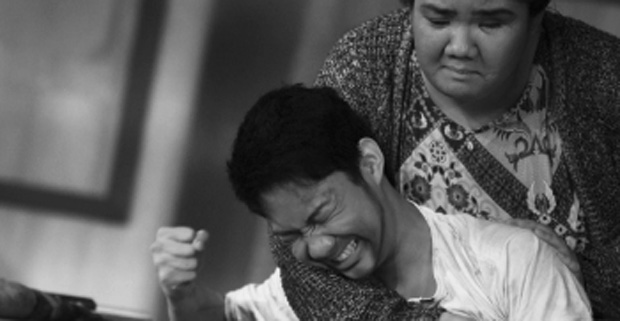
HERO. History presents facts, but the Tahanan delves into the more emotional side of the war. Photo by Mario T. Dagdag.
What makes a hero? Or a hero true? While some unsung heroes eventually have their stories told, what about those half-heroes that do not fit the mold, the should-have-beens whose actions we might never understand?
In Elsa Coscolluela’s Palanca award-winning drama Sa Tahanan ng Aking Ama, the Japanese occupation’s grey areas are colored in and the heroes, side by side with the victims, illustrate what history books never could.
The Entablado production, co-directed with Jethro Niño Tenorio and translated to Tagalog by Jerry Respeto, begins with archival videos of the occupation, a heavily-accented radio voice announcing supposedly good news, instantly bringing the audience back in time.
Against the rich white backdrop of what seems like satin and lace, bedecked by gold frames of different sizes, there unfolds all the ugliness of a war brought upon by other nations. Onstage, the pace of the story seems wanting in terms of balance—the beginning stretches into an impatience for the heavier twists and trials of the Santamarias, of a family torn apart by war.
The Ama is Carlos Santamaria, head of the affluent, educated, and influential political family of Negros. Over the dinner feast, in between toasts and laughter, and underneath the bantering is a family conflict that doesn’t take long to surface.
With the youngest son already serving as a medic in the war, the two remaining brothers, Miguel and Franco, debate on the true motives of the Japanese, the next move of the Americans, the options left. Their arguments go beyond sibling rivalry—it becomes a clash of ideologies when later on, Miguel leaves his own wife and children to become a guerilla while Franco is coerced into being governor of Negros under the puppet government.
The horrors of the war are illustrated through the women. Katrina Flores’ portrayal of the bewailing mother Amanda initially brings an ironic lightness to the stage; then she eventually switches to chastising the family for dismissing her valid worries. It’s remarkable how an actress of her age can effortlessly channel a mother’s sadness and anger at having her youngest son stolen by nationalism.
Miguel’s wife Isabel is driven to insanity as she copes with her husband’s long absence and the nagging fear for his death. Her tipping point is one of the highlights delivered by Virlynn Ramirez, whose breakdown profoundly articulates the sense of helplessness inside everyone.
Franco’s wife Cristy has no choice but to stay with the Santamarias while she worries for her own family. Mitzi Ong pulls Cristy’s character from sophisticated into an extremely cold and selfish wife—the audience is effectively torn between sympathizing with and despising her.
Even the lover of the family’s caretaker, Marisa, is victim—it is a curse to be the most beautiful woman in town while the Japanese Kempetai is king. She is in shock, and Elleonor Toledo carries her pains that are perhaps too extreme for the audience to grasp—the full weight of her suffering is brought home in the most dramatic scene when she is pushed over the edge.
But these casualties are already cliché trappings of war. Family men called into duty, neighbors and friends dying, women raped and abused. A war may make victims out of people, but it also creates heroes out of men. Throughout the play, it was the battle between the two brothers, their struggle to love and protect their family and at the same time their nation, which gave Tahanan the distinction of challenging the audience to define heroism and nationalism.
It is effective as it is timely, and the fueled co-action of Ariel Diccion as Miguel and Kalil Almonte as Franco becomes the tour de force of the production. Their honest emotions make it relatable for the new set of patriots watching the play, even if their brand of nation-building was very different from today’s choosing between yellow, orange or green ribbons. Almonte draws sympathy for his compromised decisions and actions, and his rendering makes it clear where Franco’s anguish is coming from.
Other elements of the production contribute suitably to the turn of events. The disappearance of the crisp Americanas and tailored dresses, the dimness of the lights, the anxiety elicited by that voice on the radio news—the abrupt transition from a good life to that of wretchedness.
Two projector screens showed more public service announcement videos of planes overhead and smiling soldiers, perhaps to show the progress of the war, but it was distracting at best. The aforementioned white backdrop was not a big solid wall of cloth, but in fact had passable areas in them. The effect is haunting, as the walls seem to absorb or give birth to the people passing through it.
One doesn’t quite know immediately what to make of the gold frames in the background. It went well with the first few scenes in the big old house of the Santamarias, but was too light and luxurious for a war that is too dreary. It highlighted how squalid the conditions have turned, and if taken literally, reflects how Franco was framed to be or not to be a hero.
For all the applauds one can give to Sa Tahanan ng Aking Ama, foremost would be for being the story we need today. On this year of nation-building, of elections and of great economic change, people will be called to service, to decision-making, to compromise. Romain Rolland, a French art historian and dramatist himself, describes a hero as “a man who does what he can.” Entablado gives us different kinds of heroes, of heroes we can relate to, of heroes we can be.






